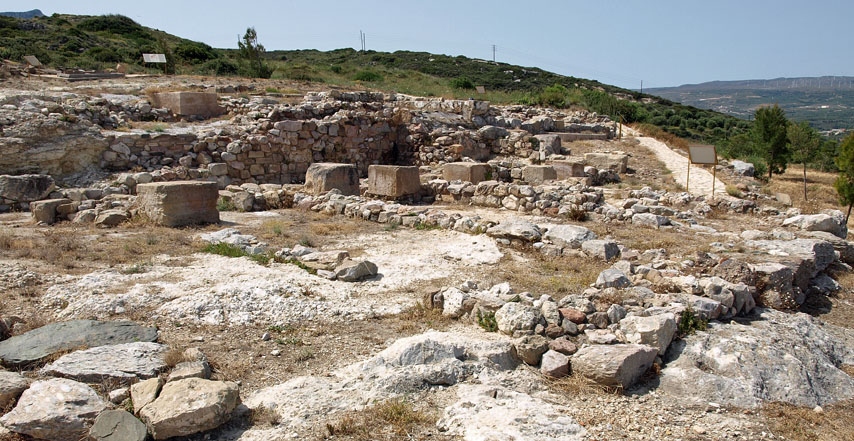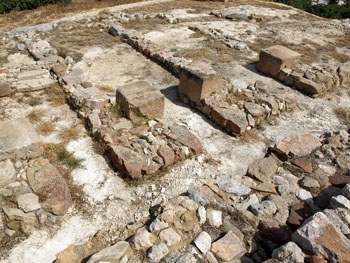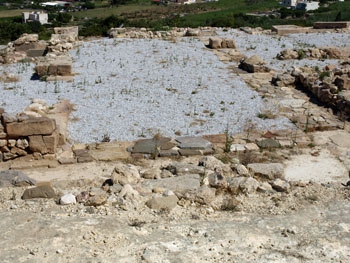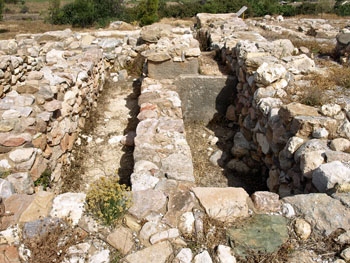
The evidence for a Palace
The Minoan site of Petras is situated a couple of kilometres east of the modern town of Siteia and it overlooks the sea from the top of a small plateau. The site has been excavated by Metaxia Tsipopoulou since 1985 and she has also been responsible for extensive work in the bay of Siteia whose aim has been to establish the Minoan settlement patterns in the area.
The Minoan township of Petras, with a central building of a palatial character, was almost certainly the main town in this part of northern Crete. The Minoan town was already large in the Early Minoan IIB period. The houses were built together in small groups, with plastered walls and red clay floors. The processing and weaving of wool seems to have taken place in the settlement as well as the production of obsidian blades.
By the Early Minoan III/Middle Minoan IA period, at the end of the prepalatial period in Crete, larger buildings were being constructed on the hill where the later palace was to be built. The first evidence also began to emerge of elites forming and possibly competing with each other. Unfortunately the levelling of the site for the palace was so extensive that no evidence remains of buildings from the Middle Minoan I period, which saw the end of the prepalatial and the beginning of the protopalatial period on Crete so there is no way of knowing whether some large building with monumental architecture predated the first palace, which was constructed in MM IIA.
The main complex is 2800 square metres in area. The designation "palatial building" is based on finds there which resemble the architectural features of the main Minoan palaces.
Storage
First of all there is evidence that storage of produce was an important aspect of the main complex. The areas devoted to storage grew towards the end of the Neopalatial period and by the end pithoi were even being stored in the courtyard. The magazines were located to the north of the central court on a north-south axis. They were constructed in LM IA during the first phase of the construction of the second palace.
During LM IB two more storage areas were added, giving a total of 214 square metres of storage space. It seems likely that storage capacity exceeded the needs of the complex which suggests an administrative and redistributive role for the complex. The existence of 44 pithoi in the magazine area demonstrates that agricultural produce from the bay of Siteia must have been centralised at Petras rather than at any of the other sites excavated in the area.
The Central Court
Secondly, there was a small central court running north-south, with a plaster floor and a drainage system using stone and plaster drains. The Central Court has now been covered with gravel to protect it so it is no longer possible to see or photograph the detail that was uncovered in the original excavation.
A central court is possibly the one essential element in identifying a building as a palace, although not all buildings which have a central court are necessarily palaces. The villa at Makriyialos, for example, has a very small central court but it is not a palace.
The palace at Petras was first erected in MM IIA and was finally destroyed in LM IB. It underwent a number of changes and the neopalatial palace was certainly less important than the protopalatial palace had been. All this was reflected in the history of the Central Court where two different phases have been identified.
The first starts in MM IIA and continues to LM IA. During this period the central court bears a similar resemblance to the central courts of other palaces. It was orientated more or less north to south and measured 17.6 metres by 7.6 metres. A monumental staircase, the remains of which are also covered in gravel today, led up to the north west corner of the Central Court from below. In the north west corner of the court there was a a square room with an entrance to the west which was no doubt used to monitor people entering up the monumental staircase.
The court was covered in a thick layer of fine white plaster and there was a double drainage system. It began at a point on the west wall of the Central Court. One branch passed north along the facade of the west wall, under the central court towards the monumental staircase where there was an outlet. The other branch ran eastwards from the same starting point beneath the central court and out below the east wall.
After the LM IA destruction alterations were made to the central court during the rebuilding of the palace. The monumental staircase was no longer used and the square room used to monitor access also went out of use and was not rebuilt. Although the total area of the court was only slightly reduced, the open part of the central court was greatly reduced in size because the eastern part of the court was covered by a stoa 4.8 metres deep and running the whole length of the court so that it effectively formed the East Wing of the palace.
It seems that the LM IB stoa was most likely an L-shaped building that ran along both the north and east sides of the central court. The east wing stoa had alternating columns and pillars. The stoa was very deep and because it only had one row of columns and pillars it could only have been a single-storey structure. Both the floor covering of the court in this period and the new drainage system were inferior to those that existed before the LM IA destruction.
The hieroglyphic archive
Inscriptions are usually associated with an administrative function. In the central building two archive tablets have so far been found. One was inscribed with Linear A while another consisted of hieroglyphic signs. The first was found in the magazine area and the second in the corridor outside the magazine area. There are also other examples of Linear A at Petras but the total number found to date is small.
The hieroglyphic archive itself was found in the west wing. The documents had fallen from the room above onto the floor below by the MM II doorway, which went out of use after the MM II destruction. Pottery found with the archive attests to its MM IIB date and the area was subsequently covered with a deposit from the LM IA period.
The excavator, Metaxia Tsipopoulou, believes that some of the finds indicate that the archive was still in use at the time of its destruction. These finds include a piece of clay the same size as some of the documents but only partly prepared; unfinished noduli of various types with their surface prepared for the impression of a seal; an unfinished medallion and a clay bar which had an uninscribed side.
The finds included various kinds of document. Firstly there were two completed four-sided clay bars. They had sign groups and numerals inscribed on them. None of the sign groups have been recognised from previous signs in hieroglyphic script from other sites in Crete.
Eight medallions were also found. All of them were inscribed with a single sign group on one side and dots which seem to represent numbers appear on the reverse side of six of them. Again the sign groups are unknown elsewhere.
Cresents are documents which usually contain inscriptions and a seal impression. One complete example was found, along with fragments of five others. Of these fragments, four had inscriptions and three had seal impressions.
The various nodules and sealings did not have any inscriptions, just seal impressions, although one seal impression might be part of a hieroglyphic inscription. It is thought that as many as 35 different seal impressions may be recorded in the archive. No evidence of Linear A was found at the site of the archive.
Monumental architecture
The architecture of the complex has similarities with palace architecture. These include ashlar masonry, pier-and-door partitions, columns and pillar combinations, particularly in the east wing stoa already described. Other important architectural features that link the complex with palace architecture include double staircases, cut slab pavements, dadoes and frescoes.
Masons' marks have also been found in great quantities in the central building. Among the marks identified are double axes, stars, branches, Linear A signs and double triangles as well as some lesser signs.




